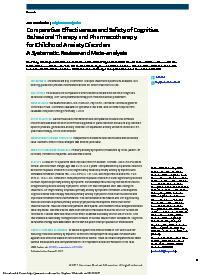Comparative effectiveness and safety of cognitive behavioral therapy and pharmacotherapy for childhood anxiety disorders : a sytematic review and meta-analysis
IMPORTANCE
Childhood anxiety is common. Multiple treatment options are available, but existing guidelines provide inconsistent advice on which treatment to use.
OBJECTIVES
To evaluate the comparative effectiveness and adverse events of cognitive behavioral therapy (CBT) and pharmacotherapy for childhood anxiety disorders.
DATA SOURCES
We searched MEDLINE, EMBASE, PsycINFO, Cochrane Central Register of Controlled Trials, Cochrane Database of Systematic Reviews, and SciVerse Scopus from database inception through February 1, 2017.
STUDY SELECTION
Randomized and nonrandomized comparative studies that enrolled children and adolescents with confirmed diagnoses of panic disorder, social anxiety disorder, specific phobias, generalized anxiety disorder, or separation anxiety and who received CBT, pharmacotherapy, or the combination.
DATA EXTRACTION AND SYNTHESIS
Independent reviewers selected studies and extracted data. Random-effects meta-analysis was used to pool data.
MAIN OUTCOMES AND MEASURES
Primary anxiety symptoms (measured by child, parent, or clinician), remission, response, and adverse events.
RESULTS
A total of 7719 patientswere included from 115 studies. Of these, 4290 (55.6%) were female, and the mean (range) agewas 9.2 (5.4-16.1) years. Compared with pill placebo, selective serotonin reuptake inhibitors (SSRIs) significantly reduced primary anxiety symptoms and increased remission (relative risk, 2.04; 95%CI, 1.37-3.04) and response (relative risk, 1.96; 95%CI, 1.60-2.40). Serotonin-norepinephrine reuptake inhibitors (SNRIs) significantly reduced clinician-reported primary anxiety symptoms. Benzodiazepines and tricyclicswere not found to significantly reduce anxiety symptoms. When CBTwas compared withwait-listing/no treatment, CBT significantly improved primary anxiety symptoms, remission, and response. ognitive behavioral therapy reduced primary anxiety symptoms more than fluoxetine and improved remission more than sertraline. The combination of sertraline and CBT significantly reduced clinician-reported primary anxiety symptoms and response more than either treatment alone. Head-to-head comparisonswere sparse, and network meta-analysis estimates were imprecise. Adverse eventswere common with medications but not with CBT andwere not severe. Studieswere too small or too short to assess suicidality with SSRIs or SNRIs. One trial showed a statistically nonsignificant increase in suicidal ideation with venlafaxine. Cognitive behavioral therapywas associated with fewer dropouts than pill placebo or medications.
CONCLUSIONS AND RELEVANCE
Evidence supports the effectiveness of CBT and SSRIs for reducing childhood anxiety symptoms. Serotonin-norepinephrine reuptake inhibitors also appear to be effective based on less consistent evidence. Head-to-head comparisons between various medications and comparisons with CBT represent a need for research in the field.
Geachte bezoeker,
De informatie die u nu opvraagt, kan door psychotraumanet niet aan u worden getoond. Dit kan verschillende redenen hebben,
waarvan (bescherming van het) auteursrecht de meeste voorkomende is. Wanneer het mogelijk is om u door te verwijzen naar de bron
van deze informatie, dan ziet u hier onder een link naar die plek.
Als er geen link staat, kunt u contact opnemen met de bibliotheek,
die u verder op weg kan helpen.
Met vriendelijke groet,
Het psychotraumanet-team.
In: JAMA Pediatrics, eISSN 2168-6211 | [171] | [11] | [November] | [1049-1056] | [Chicago, IL] : American Medical Association
http://doi.org/10.1001/jamapediatrics.2017.3036


